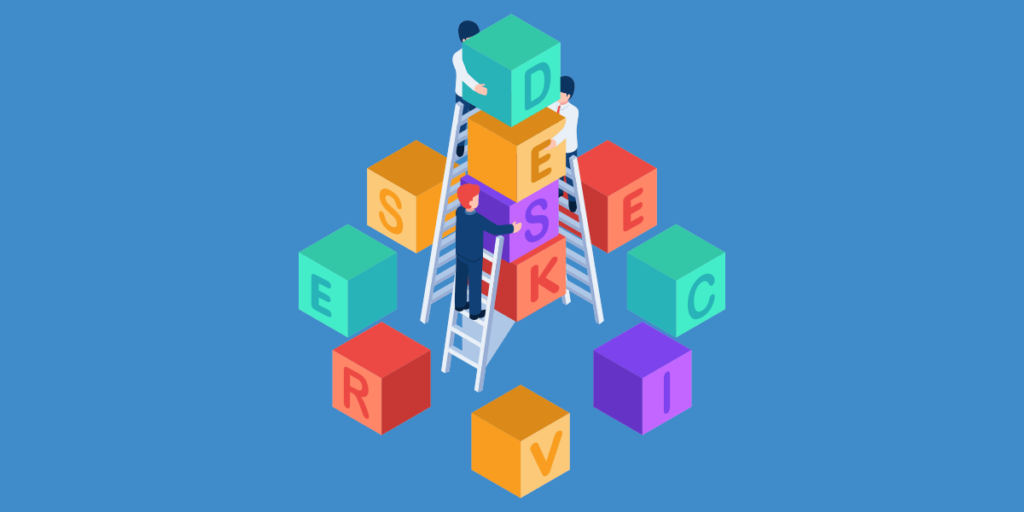Let’s talk about defining your IT service desk structure. Most, if not all, IT service desk projects are built on an IT service management (ITSM) framework, standard, or methodology. These ITSM frameworks, standards, and methodologies provide organizations with a structured approach to IT support best practices and guidance for effectively and efficiently managing IT services.
How do you know which #ITSM framework, standard, or methodology to choose for your #servicedesk? And did you know you can use more than one? Click To TweetChoose an ITSM framework, standard, or methodology
By far, the most popular ITSM framework is ITIL, which is a framework that provides a set of best practices and guidelines that organizations can use to align their IT services with the needs of the business, improve service quality, and enhance customer satisfaction. Contrary to the belief that ITIL is the only ITSM framework, many others exist, including COBIT by ISACA, VeriSM, FitSM, and Agile service management. All of these provide guidance on defining an IT service desk structure.
Choose one that speaks more to your IT service desk’s and broader ITSM purpose and objectives and that you are well-versed in (in terms of adoption and adaptation). Alternatively, your organization can take what it wants or needs from multiple ITSM frameworks, standards, and methodologies to achieve its desired ways of working and IT service desk structure.
Define your IT service desk structure
The IT service desk is the critical interface point where IT interacts daily with customers (or end-users). To deliver outstanding IT capabilities, you must ensure that your IT service desk structure consists of several key components or elements that work together to provide effective IT support that reflects the overarching business needs and goals.
First, your organization must choose an IT service desk type in terms of operation. The commonly used IT service desk types include:
- Local IT service desk – this involves establishing IT support teams or desks at different locations or departments within an organization. Dedicated IT support teams handle the IT-related requests and issues specific to that location.
- Centralized IT service desk – which acts as the central hub for all end-user interactions, providing a unified contact point for reporting incidents and requesting services. This allows IT to handle many tasks with fewer people. This can mean merging multiple local IT service desks into a centralized one that serves multiple people and departments.
- A virtual IT service desk – also known as a remote IT service desk or virtual IT support desk – this is an IT service desk structure that operates remotely, typically without a physical presence in a specific location. It leverages technology to provide IT support to end-users regardless of their geographical location.
- A follow-the-sun IT service desk – this is an IT support model designed to provide continuous support coverage across different time zones. It involves organizing teams in various locations worldwide so that when one team’s workday ends, another team in a different time zone takes over to continue providing IT support. This allows organizations to offer 24/7 support without requiring their staff to work around the clock.
So, choosing your IT service desk type will depend on your IT service desk goals, IT support team location, customer locations, criticality of the service you are offering, time zone coverage, cost, maturity of your IT service desk tool, etc.
Choosing your IT #servicedesk type depends on your IT service desk goals, IT support team location, customer locations, criticality of the service you are offering, time zone coverage, cost & more. See here. #ITSM Click To TweetIT service desk structure: IT service desk roles, responsibilities, and escalations
Second, you must define the IT service desk roles, responsibilities, and escalations. Every IT service desk needs at least one service desk manager or team lead to oversee the overall operations and performance of the IT service desk, plus other related IT support leadership responsibilities.
The other IT service desk roles and responsibilities will depend on the number of required support groups and support levels (or support tiers). The exact number and structure of support tiers may vary depending on the IT service desk’s requirements. Here are some common support levels you would typically find in an IT service desk structure:
- Tier 1 support is the initial point of contact for end-users seeking assistance in the IT service desk structure. Its main responsibility is triaging all incoming requests, ensuring they are properly prioritized, have enough information, are categorized, etc. It handles basic troubleshooting, frequently encountered issues, and routine service requests and provides initial diagnosis, guidance, and resolution whenever possible. If it cannot resolve an issue, it escalates it to the appropriate higher support tiers or specific knowledge domains for further investigation.
- Tier 2 support consists of more experienced analysts with deeper technical knowledge and expertise. It handles more complex issues that require in-depth troubleshooting and investigation beyond the scope of Tier 1 support. Responsibilities include performing advanced diagnostics, analyzing logs and system configurations, and identifying root causes. It also assists Tier 1 analysts by providing guidance, knowledge transfer, and problem-solving assistance.
- Tier 3 support represents the highest level of technical expertise within the IT service desk structure. This is specialized teams or subject matter experts who handle the most complex and critical incidents or problems. Responsibilities include advanced troubleshooting, in-depth analysis, and knowledge of specific systems, applications, or technologies. It provides guidance and assistance to Tier 1 and Tier 2 support teams, often serving as an escalation point for unresolved issues. In most cases, it is more involved in proactive support tasks than reactive support ones.
The support escalations mentioned above are called functional escalations. It’s also important to define your IT service desk’s hierarchical escalation paths, which describe how unresolved issues are escalated to higher levels of authority or management within an organization to seek resolutions.
There’s still more to come on how to set up an IT service desk; please look out for the next article in this series, which covers IT service desk processes. To view the first article in the series, please see here.
Please comment below if you would add to or change any of this IT service desk structure guidance.
Further Reading
If you enjoyed this IT service desk structure article, you may also enjoy some of the articles listed below.
Eusoph Simba
Eusoph Simba is a dedicated and accomplished ITSM manager, currently employed at a prominent cloud computing company in South Africa. With a rich background in information technology and management, Eusoph has established himself as a strategic and versatile professional in the field of ITSM. He has a BBA in computer and management information systems, a Post Graduate Diploma in knowledge and information systems, and over 10 IT-related trade certifications, including PMI-ACP, SDI, and ITIL. Eusoph can be reached at [email protected]. All opinions are his and may not represent those of his employer.

